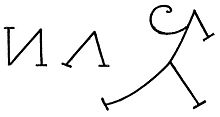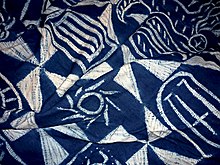History
The origin of the word nsibidi is not known. One theory traces the word to the Ekoid languages, where it means "cruel letters", reflecting the harsh laws of the secret societies that hold nsibidi knowledge.[12][13] In Calabar, nsibidi is mostly associated with men's leopard societies such as Ekpe. The leopard societies were a legislative, judicial, and executive power before colonisation, especially among the Efik who exerted much influence over the Cross River.[5]
Origin
The origin of nsibidi is most commonly attributed to the Ejagham people of the northern Cross River region, mostly because colonial administrators found the largest and most diverse nsibidi among them. Nsibidi spread throughout the region over time and mixed with other cultures and art forms such as the Igbo uri or uli graphic design.[5] In 1909 J. K. Macgregor who collected nsibidi symbols claimed that nsibidi was traditionally said to have come from the Uguakima, Ebe or Uyanga tribes of theIgbo people, which legend says were taught the script by baboons,[3] although one writer believes Macgregor had been misled by his informants.[14]
Status
Nsibidi has a wide vocabulary of signs usually imprinted on calabashes, brass ware, textiles, wood sculptures, masquerade costumes, buildings and on human skin. Nsibidi has been described as a "fluid system" of communication consisting of hundreds of abstract and pictographic signs. Nsibidi was described in the colonial era by P.A. Talbot as "a kind of primitive secret writing", Talbot explained that nsibidi was used for messages "cut or painted on split palm stems". J.K. Macgregor's view was that "The use of nsibidi is that of ordinary writing. I have in my possession a copy of the record of a court case from a town of Enion [Enyong] taken down in it, and every detail ... is most graphically described". Nsibidi crossed ethnic lines and was a uniting factor among ethnic groups in the Cross River region.[5]
Uses
Court Cases - "Ikpe"
Nsibidi was used in judgement cases known as 'Ikpe' in some Cross River communities. Macgregor was able to retrieve and translate an nsibidi record from Enyong of an ikpe judgement.
Ukara Ekpe
Nsibidi is used to design the 'ukara ekpe' woven material which is usually dyed blue (but also green and red) and is covered in nsibidi symbols and motifs. Ukara ekpe cloths are woven inAbakaliki, and then they are designed by male nsibidi artists in the Igbo-speaking towns of Abiriba, Arochukwu and Ohafiato be worn by members of the Ekpe society. Symbols including lovers, metal rods, trees, feathers, hands in friendship war and work, masks, moons, and stars are dyed onto ukara cloths. The cloth is dyed by post-menopausal women in secret, and young males in public. Ukara was a symbol of wealth and power only handled by titled men and post-menopausal women.
Ukara can be worn as a wrapper (a piece of clothing) on formal occasions, and larger version are hung in society meeting houses and on formal occasions. Ukara motifs are designed in white and are placed on grids set against an indigo background. Some of the designs include abstract symbols representing the Ekpe society such as repeating triangles representing the leopard's claws and therefore Ekpe's power. Ukara includes naturalistic designs representing objects such as gongs, feathers and manilla currency, a symbol of wealth. Powerful animals are included, specifically the leopard and crocodile.
References
- ^ University of Southwestern Louisiana (1987). Baking in the sun: visionary images from the south. University of Southwestern Louisiana. p. 30.
- ^ Asante, Molefi K. (2007). The history of Africa: the quest for eternal harmony. Routledge. p. 252. ISBN 0-415-77139-0.
- ^ Sublette, Ned (2007). Cuba and its music: from the first drums to the mambo, Volume 1. Chicago Review Press. p. 196. ISBN 1-55652-632-6.
- ^ Marshall, Richard (1992). Jean-Michel Basquiat. Whitney Museum of American Art. p. 68. ISBN 0-87427-081-2.
- ^ "West African journal of archaeology". West African Archaeological Association (WAJA by Oxford University Press) 21: 105. 1991.
- ^ a b c J. K., Macgregor (January–June 1909). "Some Notes on Nsibidi.".Journal of the Royal Anthropological Institute (Royal Anthropological Institute of Great Britain and Ireland) 39: 209–219. doi:10.2307/2843292.




No comments:
Post a Comment